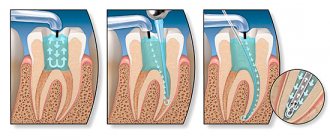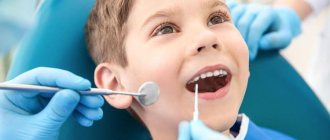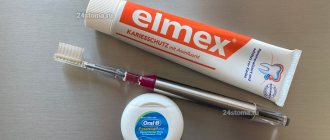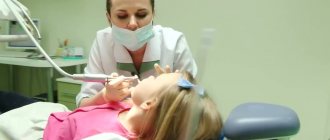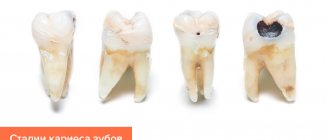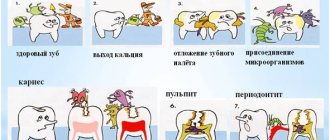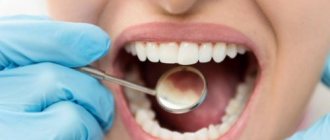Caries is the most common disease worldwide. Every person sooner or later experiences dental caries. The disease has several stages of development and at the initial stages of the pathological process it appears as a white spot. Treatment of caries in the stain stage can be treated therapeutically, that is, without preparing the tooth. There are several methods to stop the destruction of enamel and eliminate the lesion. In order to carry out treatment in a timely, painless and quick manner, it is necessary to undergo a preventive examination by a specialist every 6 months.
Causes of caries in the spot stage
There are quite a lot of theories about the occurrence of caries and the factors that cause the pathological process. Nowadays, experts adhere to the modern theory of origin. Under unfavorable conditions in the oral cavity, an acid-base imbalance occurs on the surface of the teeth. Dental deposits in the form of plaque and stone contain pathological microorganisms and food debris. Microbes process simple carbohydrates and release acids that damage the enamel structure.
At the spot stage, the enamel loses trace elements in the subsurface layer and the lesion looks like a white spot. In the absence of treatment and good hygiene, further tissue destruction occurs and a cavity forms in the tooth. In a chronic course, pigmentation of the spot may occur, then a defect appears in the form of a brown spot.
Factors that contribute to the occurrence of caries:
- Poor or insufficient hygienic care of the oral cavity. The accumulation of plaque on the dental surface is a favorable environment for the growth and development of pathological microorganisms. The infection causes various diseases of the oral cavity, negatively affects the body, and can cause exacerbation of chronic pathologies or decreased immunity. Dentists recommend regularly and thoroughly cleaning your teeth and tongue from plaque.
- Genetic predisposition. Some hereditary factors contribute to the development of the carious process: malocclusion, thickness and composition of saliva, thickness of enamel, etc.
- Disturbances in the process of formation of tooth germs. If during pregnancy there was insufficient intake of vitamins and minerals into the body of the mother and baby, then there is a risk of disruption of the normal process of formation of dental tissues. As a result, after teething, the baby’s teeth have a weak structure and are quickly susceptible to carious lesions.
- Diseases of the body. Some pathologies of the body can disrupt the composition and thickness of saliva. Oral fluid not only mechanically washes the teeth, but also participates in the process of enamel mineralization and neutralizes the effect of acids. In people with viscous saliva, the cariogenic situation in the oral cavity is often unfavorable; multiple dental lesions occur.
- Diseases of the salivary glands. Pathologies are accompanied by disturbances in the production, composition and functions of oral fluid and can, in combination with other factors, cause caries.
- Poor nutrition. An elementary lack of vitamins, minerals, and microelements in the diet can be the cause of pathology.
Infiltration - protecting enamel from bacteria
Infiltration therapy for initial caries is suitable for adults and children over three years of age. It is safe and painless, but during the procedure you will have to sit quietly in the dentist's chair for about 20 minutes. For most young children this is an overwhelming task.
Infiltration technology was invented in Germany, it has European certification and has been used abroad for a long time. In our country, the ICON method has become popular relatively recently.
What is the essence of the method. Tooth enamel has a porous structure. When bacteria penetrate the pores, intense destruction of dental tissue occurs. During the procedure, the dentist applies several compounds to the teeth in a certain sequence. The last of them acts as a sealant and seals the enamel pores. This prevents bacteria from penetrating deep into the tooth, and the carious process stops. The big advantage of this method is that the treatment is performed in one procedure and gives excellent results.
Symptoms
The initial stage of the disease is characterized by mild symptoms. The patient is not bothered by pain. The lesion rarely causes discomfort, soreness or unpleasant sensations when eating too spicy, salty, sour, or sweet foods. In the acute course of the pathological process, the formation of a chalky spot occurs at the initial stage; in the chronic case, a brown, dark spot occurs.
Caries in the spot stage often causes an aesthetic defect, especially if the lesion is located on the front teeth. A white spot can be localized in any part of the tooth, but is most often observed in the cervical area. Caries in the stain stage can be located under dental plaque, so it is detected during professional hygiene and preventive examination.
What symptoms appear with average caries?
To understand when a painful reaction to sweets occurs, you need to study the structure of the tooth a little.
In addition to enamel, the human tooth consists of dentin, and all dentin is penetrated by very thin dentinal tubules, which contain processes of odontoblast cells. These cells form the surface layer of the pulp and have their own sensitivity. They are the ones who react to sweets, they ate a piece of chocolate, the tooth ached sharply, but also quickly went away.
If only this sensitivity is present, then caries can be quickly cured, since the pulp has not yet been affected.
Types of caries
Dental caries can be single or multiple depending on the number of teeth affected. There are different types of disease depending on the location of the lesion: cervical, approximal, fissure, contact. Depending on the course, the disease can be acute or chronic.
White spot
Caries at the white spot stage is an acute pathological process of tissue destruction, which is characterized by primary damage to the enamel. It is characterized by the progressive loss of minerals by the tissue, the formation of a chalky spot. Upon examination, the enamel appears white, dull, and is easily destroyed by various irritants.
The lesion can have different sizes, round or oval shape. If left untreated, the disease enters a chronic stage or progresses and becomes acute initial caries. In this case, the enamel is destroyed and a defect is formed in the form of a cavity (hole). It is very important to identify the disease in a timely manner and eliminate it, since at the stain stage the enamel can be restored naturally without filling.
Dark spot stage
Initial caries in a chronic course looks like a brown or dark (black) spot. With prolonged flow, pigments and dyes enter the subsurface layer of enamel, which stain the tissue. It is also possible to spread infection, microbial decay products into porous enamel. This contributes to the progression of the disease and complicates treatment.
Complications
If the signs of infection are not recognized in time, then pigments begin to penetrate through the porous enamel and a dark spot forms in place of the white one. Sometimes it darkens to black. To remove the infected layer you have to use a drill. If microorganisms reach the dentin, more extensive preparation is carried out, but the treatment of superficial caries is still minimal and ends with a simple filling of the tooth.
In advanced cases, pathogens reach the pulp (nerve). Pulpitis develops
. The nerve has to be removed and the canals filled. This negatively affects the strength of the walls of the dental unit.
If inflammation affects the root of the tooth and surrounding tissues (most often occurs with cervical caries), then periodontitis
.
It is dangerous in itself, because it often leads to tooth loss, but also because it provokes coronary
heart disease [1] and endocarditis.
Diagnostics
Diagnostics is an important stage of the examination, with the help of which the doctor will accurately diagnose and determine the treatment method for caries in the spot stage. The dentist conducts a clinical examination, probing, thermal diagnostics and various diagnostic tests.
When probing, a rough enamel surface is determined. Thermal tests are negative, that is, pain does not occur when exposed to cold or hot water. In some cases, radiography is performed to rule out periodontal disease.
Samples are necessary to differentiate caries in the spot stage from hypoplasia, fluorosis and other non-carious defects. Before using dyes, the tooth is cleaned and any dental deposits are removed. The enamel is dried and a special preparation is applied (methylene blue or red, tropeolin, carmine). The stage of caries development and the boundaries of its distribution are determined by the degree of staining of the defect. Non-carious defects are not stained with dyes, so the doctor excludes them.
How does tooth decay occur during deep caries?
What happens when caries reaches the pulp? Let's look a little more closely, since there is obvious tooth decay and it is already very painful.
But since average caries is usually asymptomatic, there is a high risk of starting the disease. Then pronounced symptoms of caries appear - in this case we are talking about deep caries.
Deep caries can be located on the hard tissues of the tooth - this will be pulpitis, or it can spread to the tissues surrounding the tooth, then periodontitis occurs.
How is caries treated in the spot stage?
Treatment of caries at the white spot stage is carried out using several methods:
- Remineralizing therapy. The most popular and effective treatment method, which is carried out at the stage of only the white spot. It involves saturating the affected tissues with microelements and minerals through the application of medicinal substances. Procedures are carried out daily or every other day, the course consists of 10-15 procedures.
- Fluoridation. Treatment consists of saturating the enamel with fluorides, as well as other microelements. Fluorapatites are more durable than hydroxyapatites, thus strengthening the enamel.
- Silvering. The method involves impregnation of carious lesions with a special preparation. During the procedure, silver ions are released, which settle in the enamel and stop the destructive carious process. Currently, the method is used extremely rarely, since it is not able to eliminate caries and stains the teeth in a dark color.
- The Icon technique is the most modern technology that has many advantages. It consists of layer-by-layer application of several drugs to the white spot. The products eliminate the porous layer, remove germs and seal the enamel. In this way, the cavity is filled without the use of boron. The treatment is very effective, painless and simple.
- Grinding. If other methods are ineffective, sanding the stain, usually brown, is used. The dentist, using a special bur or brush, carefully removes the affected tissue, followed by a course of fluoridation and remineralization.
- Classic filling. If treatment with other methods is impossible, filling is used. To do this, the doctor uses a small bur to remove the destroyed tissue, and then restores the tooth with filling materials.
- Physiotherapeutic procedures. Physiotherapy procedures are used as complex therapy: electrophoresis and phonophoresis of calcium gluconate, phosphorus, sodium fluoride and other trace elements.
How is the treatment carried out?
Dental treatment consists of the following stages:
- Examination of the oral cavity, diseased tooth and collection of the patient’s medical history;
- Diagnostics, accurate diagnosis - clinical tests, x-ray diagnostics;
- Choosing the most appropriate treatment method;
- Professional teeth cleaning;
- Prescription of a course of applications, grinding or filling, depending on the method of treatment;
- Strengthening enamel and preventing hyperesthesia;
- Recommendations and advice to the patient after the procedure.
What happens if you ignore a toothache or the appearance of a small spot on a tooth?
The main cause of caries is the activity of acid-forming bacteria.
With initial caries, minerals and trace elements are “washed out” in the enamel, the so-called demineralization of the enamel. This provokes the formation of small spots and is the first signal about the beginning of the carious process. At the very beginning, as a rule, there is no pain. This is where the danger lies. Caries develops, and we continue to live without knowing it.
A dentist can detect carious cavities:
- at preventive examinations;
- when undergoing professional oral hygiene.
Caries has several stages of development.
Treatment at home
Some procedures to eliminate the disease can be performed at home. To do this, you need to visit a specialist who will carry out professional hygiene and prescribe procedures. Treatment of enamel caries in the stain stage can be carried out using professional means: toothpastes, gels, applications. Very popular and quite effective are remineralizing gels (TOOTH MOUSSE, ROCS Medical Mineral and others), medicated toothpastes with a high content of fluoride and calcium (ROCS Medical, Elmex, Biorepair).
The products are used for cleaning teeth, and also in the form of applications - applied to the required surface for 5-10 minutes daily for 1-2 weeks. The active components of the products penetrate into the lesion, promote its remineralization - restoration of the structure with mineral substances.
Self-treatment of caries without consulting a specialist is most often ineffective; the carious process does not stop and affects the underlying tissues. The therapy procedure is quite serious and requires precise, correct implementation of the dentist’s prescriptions.
The use of traditional medicine, unfortunately, will not help eliminate carious defects. There are no herbs or remedies that can stop the disease. Some traditional medicine recipes have an antiseptic, anti-inflammatory effect, and therefore can only improve the general health of the oral cavity.
Modern understanding of pathogenesis (mechanism of disease development)
In addition to Miller's theory, there are many other scientific explanations for the causes and mechanisms of caries development. The modern approach to this topic is based on three conditions, the coincidence of which leads to the development of carious tooth damage. This:
- Consumption of easily digestible (fast) carbohydrates. These include sugar, honey, starch, some cereals, sweet drinks, and confectionery. Products high in sucrose, glucose and lactose are especially harmful. They form a plaque on the enamel that interferes with the neutralizing effect of saliva.
- Growth of cariogenic microflora. Now there is no doubt that without pathogenic microorganisms, caries does not develop. In addition to the main “culprit” Str. mutans, cariogenic bacteria also include Str. Sanguis, Str. Salivarius.
- Low enamel resistance. The resistance of a tooth to damaging factors depends on the quantity and quality of the organic and inorganic components of the enamel.
Prevention of caries
The main method of preventing the disease is maintaining regular and high-quality hygienic care for the oral cavity. You should brush your teeth 2-3 times a day using selected and suitable hygiene products. Experts also recommend:
- Clean the interdental spaces daily with floss (dental floss);
- After each meal, rinse the mouth; if impossible, use chewing gum;
- If you have dentures or orthodontic structures, use an irrigator;
- Adhere to a proper healthy diet that will fully cover the daily dose of vitamins and minerals;
- Carry out professional cleaning and preventive examination 2 times a year;
- Treat chronic diseases of the body;
- Increase immunity.
We can conclude that treatment of caries in the spot stage is relatively simple, affordable and absolutely painless. It is important to diagnose and eliminate the pathological process in time, and for this it is necessary to examine the dentition yourself and visit the dentist every 6 months for preventive purposes.
Classification of caries by location
The Black classification system includes five types of caries:
Caries on the chewing surface of the tooth
Caries on the lateral surface of the tooth
Caries on the lateral surface of the central tooth with destruction of the cutting edge
Cervical dental caries
Now this system is to some extent outdated, since modern filling materials have a wide range of applications. And the dentist makes a choice between filling methods, because a filling, to some extent, is also a prosthesis. The doctor chooses how best to place a filling and what type of construction to make.
What about the treatment of caries? We’ll tell you about the treatment of caries, the types of fillings, inlays and other benefits for teeth in another article.
What does caries look like under a microscope?
Caries looks very interesting under a microscope, especially if you look at it on a tooth cut. Below you can see what superficial, medium and deep forms of caries look like. In addition, in each photograph in the center of the tooth crown you can see the cavity (pulp chamber) in which the neurovascular bundle of the tooth is located.
When is the outcome of treatment of initial caries considered successful?
The initial stage of caries is the easiest to correct, but incomplete or poor-quality treatment almost always leads to the transition of the disease to the next, more serious, stage. The outcome of treatment of initial caries is considered successful when:
- the carious stain disappeared, the tooth color became uniform;
- repeated diagnostics confirms the absence of traces of enamel demineralization;
- there is no reaction to temperature stimuli and the feeling of soreness, which sometimes appears at the stage of initial caries, disappears.
Should I go to the dentist?
Recently, my old friend from Rogachev (the city where I grew up) called me and said that her husband had a white spot on his tooth. I advised her husband to go to the dentist. “Or maybe I should just brush my teeth better and the stain will go away on its own? Or maybe there is some gel that can be used at home?” she doubted. Unfortunately, brushing your teeth, even the most thorough, will no longer help during the staining phase. As an additional prevention, you can use remineralizing gels. They enrich tooth enamel with minerals and protect teeth from acids. But I strongly recommend that you consult a dentist who can help you choose the right remineralizing agent for you.
Make an appointment +375 29 604-61-61
